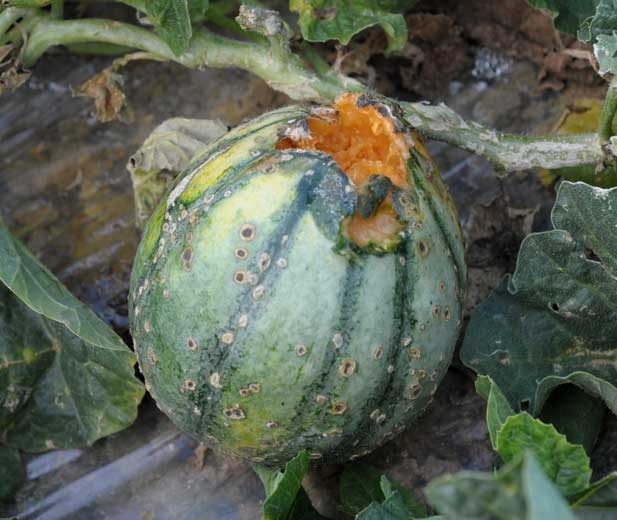
Rhizopus stolonifer (Ehrenb.) Vuill. (1902)
Rhizopus rot
- Classification: Fungi, Zygomycota, Mucoromycotina, Incertea seat, Incertea seat, Mucorales, Mucoraceae
- synonyms: Rhizopus nigricans Ehrenb. , (1821)
- English name: Rhizopus rot
R. stolonifer is a very cosmopolitan fungus reported almost on every continent in the world. It causes soft and liquid rots on various plants and various organs (mainly fruits) especially at the time of harvest and during storage. These rots show some similarities to those caused by bacteria. It is also responsible for black mold in bread.
It is reported on Cucurbitaceae in several production areas around the world, responsible for fruit rot occurring in pre and post harvest during storage. Melon is particularly affected, but also cucumber, zucchini, squash ...
Note that another species, R. arrhizus , is also reported on Cucurbitaceae.
Symptoms
These are often moist and located at the end of the fruits. Affected tissues, moist and soft ,. The fruits can completely liquefy in a few days.
Wet, soft lesions spreading rapidly on mature fruits, often from their stylar (Figure 1) or stalk (Figure 2) ends, or even wounds (Figure 3). Affected tissues take on a translucent appearance and dark tint, liquefy and eventually collapse (Figures 4 and 5). Juice flows may be observed.
The mycelium of the fungus invades the tissues, and a whitish to greyish mold subsequently covers them (Figures 2, 3 and 5). It is made up of the mycelium, sporocystophores and sporocysts of this zygomycete. In the long term, numerous rather aerial fruiting bodies, in “black pinheads”, are visible on the damaged tissues (figure 6).
A slight acid odor can accompany these rots on melon, as well as the presence of fruit flies (figure 7).
Care should be taken not to confuse this mold with that produced by a neighboring fungus, Choanephora cucurbitarum , which causes quite similar symptoms on the fruits of Cucurbitaceae.
Elements of biology
R. stolonifer often lives in the saprophytic state on the melon and in its environment, becoming an opportunistic pathogen when the physiological state of the melons is modified (presence of wounds, advanced maturity ... ).
- Conservation et sources d'inoculum
Ce champignon saprophyte par excellence et très ubiquiste est présent sur de nombreux débris végétaux sur et dans le sol, et sur divers fruits sénescents. Il provoque des dégâts sur diverses plantes : plusieurs Cucurbitacées, aubergine, tomate, fève, patate douce, abricot, pêche, prune, maïs...
- Pénétration, invasion
- stolonifer is an opportunistic fungus which settles on Cucurbits from senescent floral organs . For example, the wilted corollas, which persist longer than usual in humid periods, constitute nutritive bases allowing them first to settle and then secondly to colonize the fruits and cause them to rot. Stamens and pistils can also be colonized.
It can also penetrate the fruit through a wide variety of injuries: picking stalk wound, growth cracks , sunburn , apical necrosis, insect bites, various shocks, etc.)
Subsequently, its mycelium grows very extensively, growing in all directions inside the flesh which gradually decomposes thanks to the action of various enzymes.
- Sporulation and dissemination of the fungus
- stolonifer , which evolves rapidly in fruits, soon sporulates in the form of numerous sporangiophores harboring innumerable black spores in spore vesicles (Figures 8 to 10). These are very present in the air and are dispersed by the wind over long distances, as well as by splashing water and certain insects.
- Conditions favorable to its development
It grows rapidly and sporulates abundantly in the presence of humidity and when temperatures are mild. Its growth is rapid between 15 and 30 ° C and its thermal optimum for development is between 23 and 28 ° C.
Protection methods
- During cultivation
It is often difficult to control effectively R. stolonifer during cultivation. We can, however, recommend the implementation of the following measures:
- manage the best irrigation so that they are fair and never excessive;
- avoid sprinkling irrigations, otherwise perform them at the beginning or during the day to allow the plants to dry up quickly;
- if symptoms appear under shelter, it is imperative to reduce the ambient humidity by ventilating them as much as possible;
- eliminate during and at the end of cultivation the fruits more or less rotten ;
- avoid to hurt the fruit and harvest at advanced maturity.
Specific treatments fungicide are rarely necessary. Very often, they are ineffective because flowers are constantly formed and the fruits more or less buried in the vegetation are only partially protected.
- Next crop
The efficiency of crop rotations proves quite disappointing ; this situation is certainly due to polyphagia and the saprophytic potential of this fungus
The soil of the future plots of Cucurbitaceae will be well worked and drained in order to avoid the formation of puddles. In the open field, the rows of planting will be oriented in the direction of the prevailing winds so that the plant cover is well ventilated. The plants can be placed on boards. The use of plastic mulch will partially isolate the vegetation from the ground and therefore help reduce contamination.
The other diseases and pests must be controlled because they are the cause of wounds and tissue necrosis conducive to the establishment of R. stolonifer . Infected flowers and fruits should be removed and disposed of.
To our knowledge, no resistance to this fungus has been reported in cultivated Cucurbits.
Finally, note that this fungus is sensitive to the mycoparasite Piptocephalis virginiana .
* Chemical control : As the number of pesticides available for a given use is constantly changing, we advise you to always confirm your choice by consulting the e-phy site of the Ministry of Agriculture and Fisheries which is an online catalog of plant protection products and their uses, fertilizers and growing media approved in France. This also applies to all biological products based on microorganisms or natural substances.





